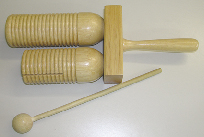| Approach: One
to one |
Level:
4 &
8
|
|
| Focus:
Interpretation
and representation of symbols to sounds
|
| Resources:
5 cards, agogo
woodblock, beater, answer sheet |

179kb |
|
|
|
Questions/instructions:
Hand out
agogo woodblock.
In this activity you are going to make up a piece of music for this
instrument which is called an agogo woodblock. First, have a go at making
as many different sounds as you can.
Try using the stick in different ways.
Allow time.
After student has experimented, place the practice card in front of
the student. |
|
%
responses
|
| y4
|
y8 |
| 1.
Think about the sounds you could make with the agogo woodblock to go with
these symbols, then have a go at playing them. |
|
|
| 2.
Why did you make those sounds? What was it about the symbols that made
you choose those sounds? |
| Practice
card interpretation:(link between symbols and sounds) |
strong |
47
|
57 |
moderate
|
37 |
34 |
weak
|
16 |
9 |
Set out cards
1 to 4 in order.
I’ve
put these cards in order from card 1 to card 4. Take some time to try
out playing sounds for each row, starting with card 1 and carrying on
to card 2, 3, then 4. After you have practised, I’ll ask you to
play your music.
Allow time.
Now play your music starting from card 1 then carrying on to
card 2, 3, then 4.
|
|
Cards 1 – 4: |
|
|
Interpretation:
|
|
|
strong
and consistent for same symbols on different cards |
34 |
46 |
strong
on each card but not consistent |
29 |
30 |
moderate
|
27 |
19 |
weak
(random) or no response |
10 |
5 |
Inventiveness:
|
|
|
strong
(at least 3–4 different sounds) |
49
|
57 |
moderate
42 36 |
|
|
weak
9 7 |
|
|
Hand
out paper and pencil.
Now you can compose your own piece of music. On this piece of paper I
want you to draw some symbols for your music. Take time to try some different
combinations and think about how you can draw them on the paper. When
you are ready, you can play your piece for me to listen to.
Allow time.
Now you can play your music for me to listen to.
Student plays music.
To finish off, I would like you to tell me about the symbols you made
up, and why you played them the way you did. |
|
|
| Own
composition: (symbols,
performance and explanation) |
|
|
Representation:
(link between symbols and sounds)
|
|
|
strong
|
55 |
74 |
moderate
|
34 |
21 |
weak
|
11 |
5 |
Inventiveness:
|
|
|
strong
|
36 |
43 |
moderate
|
53 |
48 |
weak
|
11
|
9 |
Effectiveness
as a musical composition:
(consider performance for sense of unity and completion, appropriate
range and repetition of sounds, cohesiveness and confidence)
|
|
|
strong
|
32 |
48 |
moderate
|
58 |
47 |
weak
|
10 |
5 |
Explanation/justification:
|
|
|
strong
(using musical terms) |
12
|
24 |
moderate
|
65 |
64 |
weak
|
23 |
12 |
Total
score: 12 – 13 |
18
|
29 |
10
– 11 |
22
|
27 |
8
– 9 |
27
|
25 |
6
– 7 |
17
|
12 |
4
– 5 |
8 |
5 |
0
– 3 |
8
|
2 |
Commentary:
About 40 percent of year 4 students and 55 percent of year 8 students
performed quite strongly on this task. The weakest element was the
verbal explanation for the choice of symbols and why they were played
the way they were. |
 |
|